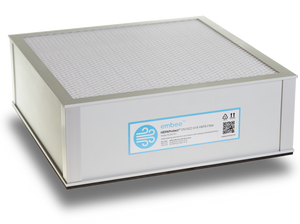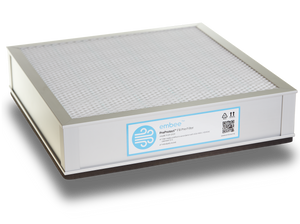The Deadly Burden of Hong Kong's Poor Air Quality
Air pollution in Hong Kong is an under-appreciated health and environmental crisis, placing an enormous burden on the health of residents. Globally, the WHO estimates that ambient (i.e. outdoor) air pollution causes the premature death of 4.2 million people annually, with the greatest burden in South-East Asia and the Western Pacific regions.
This mortality is due to exposure to small particulate matter of 2.5 microns or less in diameter (PM2.5), which cause cardiovascular and respiratory disease, and cancers - It is estimated that approximately 3% of cardiopulmonary and 5% of lung cancer deaths are attributable to particulate pollution globally.
Hong Kong PM2.5 levels regularly exceed WHO limits
The WHO annual average limit for PM2.5 fine particulate pollution is 15 μg/m³:
- In 2019, every one of the 16 pollution monitoring stations that track this data in Hong Kong exceeded this limit.
The WHO daily average limit for PM2.5 fine particulate pollution is 25 μg/m³. This limit may be exceeded a maximum of 3 days per year:
- In 2019, the Central/Western monitoring station exceeded this level on 110 days.
No safe level
It's worth noting that these limits do not represent safe levels - no safe level has been identified, below which negative health outcomes do not occur.
For example a Japanese study showed that over a 2-year period where the average PM2.5 level was only 12μg/m³, each 10μg/m³ increase in levels resulted in a 3-4% increase in cardiac arrests (heart attacks).
Embee recommends monitoring levels in your location and timing outdoor activities to minimize exposure when levels are excessive. Current levels and recommendations for HK districts and primary/secondary schools can be monitored here:
What are the health implications for Hong Kong residents?
Hong Kong's poor air quality places a heavy health burden on residents:
Outdoor air pollution kills an estimated 6300 people per year in Hong Kong, or an average of 17 per day. School of Public Health and Primary Care, CUHK
Deaths primarily result from heart disease, stroke, other cardiovascular and respiratory diseases, and cancer.
“[There is a] strong association between high pollution incidents and both hospital admissions and premature deaths for respiratory and cardiovascular diseases”. Center for Health Protection, HKSAR
Air pollution in pregnancy has been linked to premature birth, stillbirth, impaired fetal growth and birth abnormalities including abnormal heart valves and cleft palate.
Where does Hong Kong’s air pollution come from?
- Contrary to popular belief, most of Hong Kong's air pollution is generated locally.
- Shipping is the biggest contributor, with power stations and diesel vehicles and construction machinery also substantial sources.
- Hong Kong allows container ships to burn cheap and dirty 0.5% sulfur content fuel while in Hong Kong waters and at berth.
- This is 5 times the 0.1% limit in Europe, North America, South Korea, and China’s Yangtze / Xi Jiang river areas and Hainan Coastal ECA.
- At the roadside, diesel vehicles and construction machinery are the primary source.
This is easily seen on Embee's air quality monitoring pages, where local sources result in poorer air quality nearby:

Below are additional links to Hong Kong air pollution advocacy/charity organisations, related government websites, pollution complaint forms, as well as more detailed information on individual pollutants.
Hong Kong air pollution related advocate/charity organisations
-
Clean Air Network
CAN's vision is to build a Hong Kong with clean air through policy change, knowledge building, and collaboration. -
Clear The Air
Clear the Air (CTA) is committed to the introduction and implementation of measures to significantly reduce air pollution in Hong Kong, through advocacy and education.
Related HK Government websites
- Environmental Protection Department
https://www.epd.gov.hk - Government air quality information for residents
https://www.gov.hk/en/residents/environment/air/ - Centre for Health Protection - the Health Effects of Air Pollution
https://www.chp.gov.hk/en/healthtopics/content/460/3557.html
Pollution complaints
- Smokey vehicle complain form
https://cd.epic.epd.gov.hk/EPICCOM/smoky/ - General pollution complaints
https://www.gov.hk/en/residents/environment/public/?subcat=enquiries
Particulate Matter (PM) affects more peoples' health than any other pollutant.
It consists of billions of tiny particles (PM2.5 is about 1/30 the width of a human hair) made of everything from nitrates and ammonia to black carbon and mineral dust.
Primary sources in Hong Kong are ships, trucks, coal power stations in Lamma and Castle peak, and construction activities
PM2.5 particles are so small that when inhaled, they can pass directly into your bloodstream, and then around your body to organs including the brain.
There is strong evidence linking PM2.5 pollution levels to heart disease, cancer, strokes, and COPD.
PM2.5 has health impacts even at very low concentrations – no threshold has been identified below which no damage to health is observed.
(O3)
A highly reactive gas formed by other pollutants from ships, vehicles and power stations reacting with sunlight.
Ozone is the primary contributor to the "smog" most people associate with air pollution.
Short-term effects:
- Shortness of breath, wheezing, coughing, and inflammation of the airways.
- Asthma attacks and increased risk of respiratory infections.
- Increased hospital admissions for those with COPD, asthma, and other lung diseases.
Longer-term effects:
- Development of asthma in adolescents and reduced lung function.
- Higher risk of death from respiratory diseases.
- Low birth weight and decreased lung function in newborns.
An acidic gas generated during combustion in ships, vehicles, and power stations.
NO2 along with other NOx also reacts with other chemicals in the air to form both particulate matter and ozone
NO2 is toxic at levels >200 μg/m³, causing significant inflammation of the airways.
Typical immediate effects include:
- Shortness of breath, wheezing, coughing, and inflammation of the airways.
- Increased risk of respiratory infections.
- Asthma attacks.
- Increased hospital admissions for those with COPD, asthma, and other lung diseases.
Reduced lung function and development of asthma is linked to NO2 levels that are commonly experienced in Hong Kong.
SO2 irritates the eyes and respiratory system, aggravates asthma and chronic bronchitis, and makes people more prone to infections of the respiratory tract.
When SO2 levels are high, hospital admissions and deaths from cardiac disease increase.
- Ambient (outdoor) air pollution WHO
- Health Effects of Particulate Matter. WHO
- Developing an Instrument for Assessing the Health and Economic Impacts of Air Pollution in Hong Kong - Final Report. School of Public Health and Primary Care The Chinese University of Hong Kong
- The Health Effects of Air Pollution. Centre for Health protection, Department of Health, The Government of the HKSAR.
- Short-term exposure to ambient fine particulate matter and out-of-hospital cardiac arrest: a nationwide case-crossover study in Japan
https://www.thelancet.com/journals/lanplh/article/PIIS2542-5196(19)30262-1/fulltext




